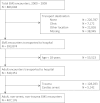Severe sepsis in pre-hospital emergency care: analysis of incidence, care, and outcome
- PMID: 23087028
- PMCID: PMC3622444
- DOI: 10.1164/rccm.201204-0713OC
Severe sepsis in pre-hospital emergency care: analysis of incidence, care, and outcome
Abstract
Rationale: Severe sepsis is common and highly morbid, yet the epidemiology of severe sepsis at the frontier of the health care system-pre-hospital emergency care-is unknown.
Objectives: We examined the epidemiology of pre-hospital severe sepsis among emergency medical services (EMS) encounters, relative to acute myocardial infarction and stroke.
Methods: Retrospective study using a community-based cohort of all nonarrest, nontrauma King County EMS encounters from 2000 to 2009 who were transported to a hospital.
Measurements and main results: Overall incidence rate of hospitalization with severe sepsis among EMS encounters, as well as pre-hospital characteristics, admission diagnosis, and outcomes. Among 407,176 EMS encounters, we identified 13,249 hospitalizations for severe sepsis, of whom 2,596 died in the hospital (19.6%). The crude incidence rate of severe sepsis was 3.3 per 100 EMS encounters, greater than for acute myocardial infarction or stroke (2.3 per 100 and 2.2 per 100 EMS encounters, respectively). More than 40% of all severe sepsis hospitalizations arrived at the emergency department after EMS transport, and 80% of cases were diagnosed on admission. Pre-hospital care intervals, on average, exceeded 45 minutes for those hospitalized with severe sepsis. One-half or fewer of patients with severe sepsis were transported by paramedics (n = 7,114; 54%) or received pre-hospital intravenous access (n = 4,842; 37%).
Conclusions: EMS personnel care for a substantial and increasing number of patients with severe sepsis, and spend considerable time on scene and during transport. Given the emphasis on rapid diagnosis and intervention for sepsis, the pre-hospital interval may represent an important opportunity for recognition and care of sepsis.
Figures



Comment in
-
Has the time for advanced pre-hospital care of severe sepsis finally arrived?Am J Respir Crit Care Med. 2012 Dec 15;186(12):1204-5. doi: 10.1164/rccm.201210-1895ED. Am J Respir Crit Care Med. 2012. PMID: 23250496 No abstract available.
-
Reply. Severe sepsis: stay and play or scoop and run?Am J Respir Crit Care Med. 2013 Aug 15;188(4):513-4. doi: 10.1164/rccm.201302-0293LE. Am J Respir Crit Care Med. 2013. PMID: 23947522 Free PMC article. No abstract available.
-
Severe sepsis: stay and play or scoop and run?Am J Respir Crit Care Med. 2013 Aug 15;188(4):513. doi: 10.1164/rccm.201301-0138LE. Am J Respir Crit Care Med. 2013. PMID: 23947523 No abstract available.
References
-
- Dombrovskiy VY, Martin AA, Sunderram J, Paz HL. Rapid increase in hospitalization and mortality rates for severe sepsis in the united states: a trend analysis from 1993 to 2003. Crit Care Med 2007;35:1244–1250 - PubMed
-
- Heron M, Hoyert DL, Murphy SL, Xu J, Kochanek KD, Tejada-Vera B. Deaths: final data for 2006. Natl Vital Stat Rep 2009;57:1–134 - PubMed
-
- Kumar G, Kumar N, Taneja A, Kaleekal T, Tarima S, McGinley E, Jimenez E, Mohan A, Khan RA, Whittle J, et al. Nationwide trends of severe sepsis in the 21st century (2000–2007). Chest 2011;140:1223–1231 - PubMed
-
- Perl TM, Dvorak L, Hwang T, Wenzel RP. Long-term survival and function after suspected gram-negative sepsis. JAMA 1995;274:338–345 - PubMed
MeSH terms
Grants and funding
LinkOut - more resources
Full Text Sources
Other Literature Sources
Medical

